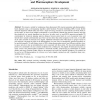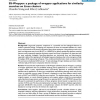220 search results - page 40 / 44 » Using genetic programming to obtain implicit diversity |
JCC
2008
13 years 7 months ago
2008
Abstract: We present a method for simultaneous three-dimensional (3D) structure generation and pharmacophorebased alignment using a self-organizing algorithm called Stochastic Prox...
ECML
2006
Springer
13 years 11 months ago
2006
Springer
Research in the rule induction algorithm field produced many algorithms in the last 30 years. However, these algorithms are usually obtained from a few basic rule induction algorit...
IJBRA
2008
13 years 7 months ago
2008
Abstract Observing behaviors of protein pathways and genetic networks under various environments in living cells is essential for unraveling disease and developing drugs. For that ...
BMCBI
2004
13 years 7 months ago
2004
Background: Large-scale sequence comparison is a powerful tool for biological inference in modern molecular biology. Comparing new sequences to those in annotated databases is a u...
CP
2003
Springer
14 years 25 days ago
2003
Springer
Multiple sequence alignment is a central problem in Bioinformatics. A known integer programming approach is to apply branch-and-cut to exponentially large graph-theoretic models. T...


